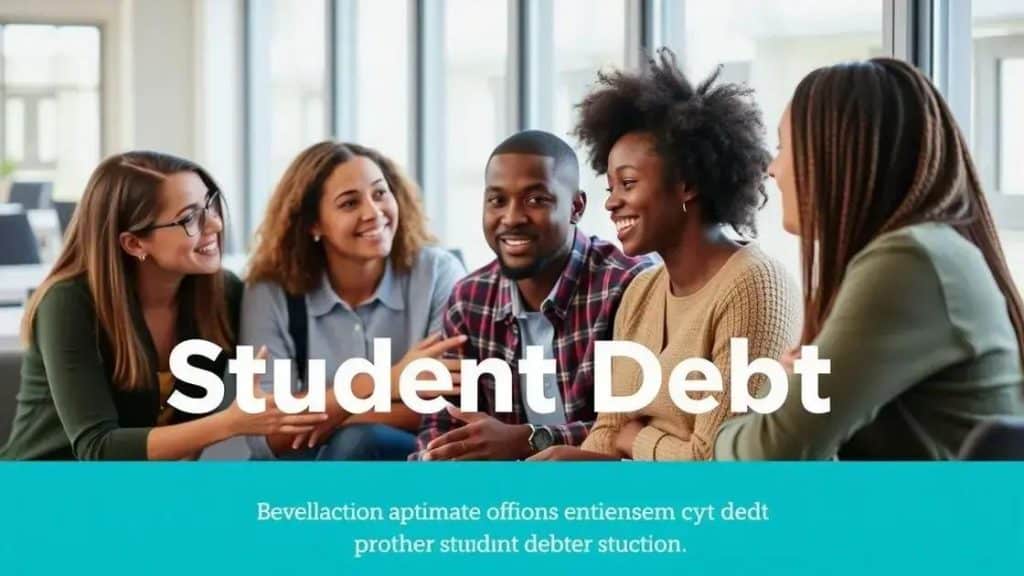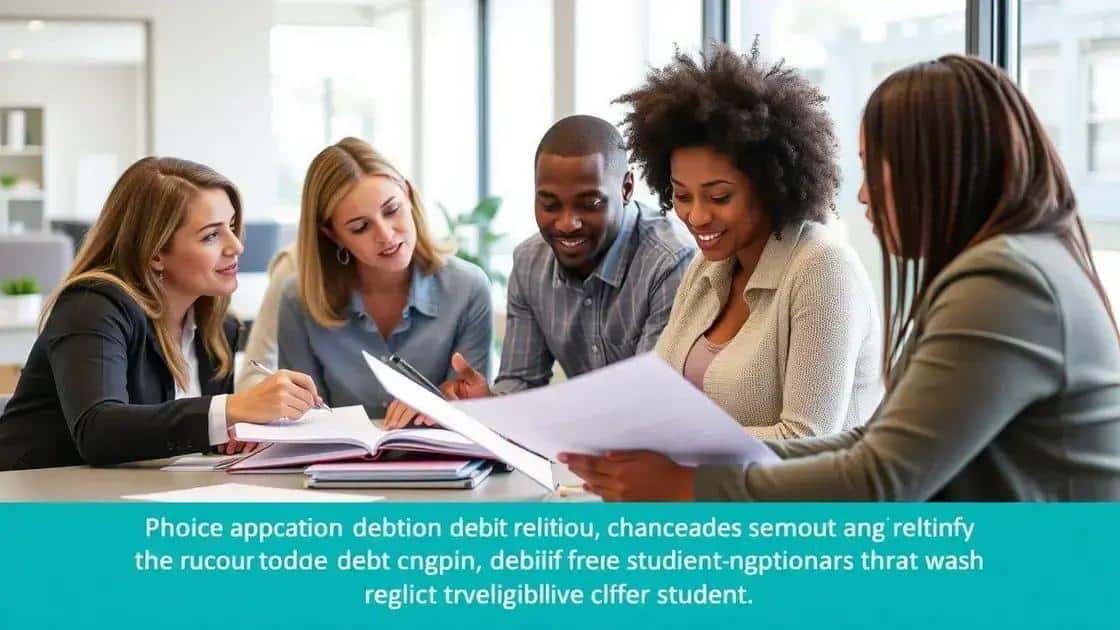Student debt relief: what options are available?

Student debt relief programs provide effective options for borrowers to reduce or eliminate their student loans, ultimately improving financial stability and enhancing credit scores.
Student debt relief is more than just a buzzword; it represents hope for millions grappling with loans. Have you ever wondered how these programs can actually lighten your financial load? In this article, we’ll explore different avenues for alleviating that burden.
Understanding student debt relief programs
Understanding student debt relief programs can empower borrowers to take proactive steps toward managing their financial obligations. With many options available, it’s essential to know what each program offers.
Types of Student Debt Relief Programs
There are various types of programs designed to help ease the burden of student loans. Here are a few key categories:
- Income-driven repayment plans: These adjust your monthly payment based on your income, making it easier to manage payments.
- Public Service Loan Forgiveness: This program forgives the remaining loan balance for borrowers who work in qualifying public service jobs.
- Teacher Loan Forgiveness: Certain teachers can receive forgiveness on a portion of their federal loans after teaching in low-income schools for five consecutive years.
These options vary in eligibility and benefit, so it’s vital to assess which is best for your situation. Understanding each program’s requirements can help you make informed decisions.
Applying for Student Debt Relief
Applying for student debt relief can seem daunting, but it’s crucial to start the process. Many programs have specific application periods and required documentation. You’ll need to gather your financial records, employment details, and loan information before applying.
Staying organized will enhance your chances of successful application. Frequent updates to your loan servicer can also help ensure that you remain informed about your options and any changing rules related to student debt relief.
Benefits of Student Debt Relief
There are numerous benefits to engaging with student debt relief options. Some of these include:
- Reduced financial stress, enabling borrowers to focus on other priorities.
- Improved credit scores once debts are managed better.
- The ability to pursue career opportunities without the burden of large monthly payments.
By understanding student debt relief programs, you can explore all available avenues and choose the right fit for your needs.
Eligibility criteria for debt relief options

Understanding the eligibility criteria for debt relief options is essential for borrowers seeking financial assistance. Each program has unique requirements, which can greatly influence your ability to qualify.
Common Eligibility Requirements
Many debt relief programs share similar eligibility criteria. It’s important to be aware of these standard requirements:
- Loan Type: Most programs apply to federal loans, while private loans may not qualify.
- Payment History: Having a positive repayment history can enhance your chances of approval.
- Income Level: Some programs depend on your income, making it vital to assess your financial situation.
It’s crucial to review your loan details and financial standing to determine which programs you might qualify for. While the criteria can seem overwhelming, being informed will help you navigate your options.
Specific Programs and Their Criteria
Each relief program comes with its specific set of guidelines. For instance:
- Public Service Loan Forgiveness: To qualify, you must work for a qualifying employer for at least 10 years.
- Income-driven Repayment Plans: You must provide proof of income to get your payments adjusted.
- Teacher Loan Forgiveness: This requires teaching in low-income schools for a minimum of five consecutive years.
It’s essential to gather the necessary documentation early in the process. This proactive approach will ensure you meet the requirements and can complete applications smoothly.
Remember, checking for eligibility is just the first step. Once you know what you qualify for, you can take steps to apply confidently.
How to apply for student debt relief
Knowing how to apply for student debt relief is crucial for anyone looking to lighten their financial burden. The application process can vary depending on the specific program you choose. However, there are common steps you will generally follow.
Gather Required Documents
Before starting your application, make sure you have all necessary documentation ready. This may include:
- Your Social Security number and other identification.
- Income verification documents, such as pay stubs or tax returns.
- Details of your current loans including balances, servicers, and types.
Having your documents organized will make the process smoother and quicker, ensuring you don’t miss important information.
Choose the Right Program
Next, explore different relief options to find the one that best fits your circumstances. Programs might include:
- Income-Driven Repayment Plans: Adjust payments according to your income.
- Public Service Loan Forgiveness: Forgive loans after a certain period in a qualifying job.
- Teacher Loan Forgiveness: For eligible teachers who work in low-income schools.
Read the qualifications for each program to determine which one suits your needs. This step is vital to ensure you are applying for the right relief.
Submit Your Application
Once you have gathered your documents and selected a program, it’s time to submit your application. Most applications can be completed online through your loan servicer’s website. Be sure to double-check:
- That all information is accurate and complete.
- That you have signed all necessary forms.
- That you keep copies of everything you submit.
After your application is submitted, it may take time to review. Patience is key as you await a response regarding your eligibility.
Remember, applying for student debt relief can make a significant difference in managing your financial future. Staying informed and following the steps carefully can increase your chances of approval.
The impact of debt relief on your finances

The impact of debt relief on your finances can be significant and positively transformative. Many borrowers experience relief not just from payments but also from the emotional burden that student debt can cause.
Financial Freedom
One of the greatest benefits of debt relief is achieving greater financial freedom. Reduced or eliminated payments allow you to allocate funds to other important areas, such as:
- Saving for emergencies: With less money going to debt, you can build an emergency fund.
- Investing in Future Goals: This might include buying a home or saving for retirement.
- Enhanced Daily Living: Less debt means more disposable income for everyday expenses.
As you become more financially stable, you may also notice a positive shift in your lifestyle and overall well-being.
Improved Credit Score
Another essential impact of receiving debt relief is the improvement in your credit score. When debt is reduced or managed better, your credit utilization ratio improves. This can lead to:
- Lower interest rates on future loans.
- Increased chances of loan approval.
- Better creditworthiness in general.
A higher credit score can provide access to favorable financing options in the future, making significant purchases more achievable.
Long-Term Financial Planning
Relief from student debt can also allow for better long-term financial planning. By alleviating monthly payment stress, you can focus on:
- Setting long-term financial goals, such as retirement or children’s education.
- Planning for larger expenses without the constant worry of student loans.
- Exploring investment opportunities that may not have been feasible previously.
Ultimately, receiving debt relief not only improves your current financial situation but also sets you up for a more secure and financially sound future.
FAQ – Frequently Asked Questions about Student Debt Relief
What is student debt relief?
Student debt relief refers to programs that help borrowers reduce or eliminate their student loan debt through various means.
Who is eligible for student debt relief programs?
Eligibility varies by program but generally includes criteria like loan type, employment in public service, and income level.
How can I apply for student debt relief?
To apply, gather required documents, choose the right program, and submit your application through your loan servicer.
What are the benefits of student debt relief?
Benefits include reduced monthly payments, improved credit scores, and greater financial freedom to pursue other goals.





